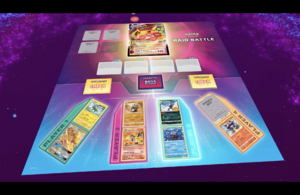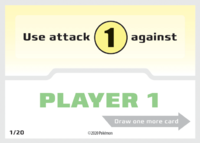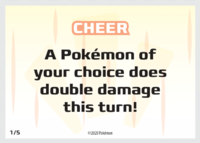Raid Battle (TCG)
Pokémon Trading Card Game Raid Battle is a cooperative type of battle that is played using cards from the Pokémon Trading Card Game. It is based on the Max Raid Battles of Pokémon Sword and Shield, allowing up to four players to work together to defeat a powerful Dynamax or Gigantamax Pokémon. It was revealed on July 13, 2020. Playing the game requires a number of components: both Pokémon cards and a variety of other materials specific to this game. However, a Digital Raid Battle Assistant can be run on a computer to bypass the need for the second set of materials and otherwise automate some elements of the game.
In 2022, the Alternative Play Handbook introduced Raid Format. It is a second representation of a Raid Battle in the Trading Card Game that uses more of the standard rules of the Trading Card Game than Raid Battle.
Mechanics
Raid Battles utilize Pokémon cards but have altered or removed mechanics from the standard Trading Card Game. The following mechanics have been removed entirely:
- Evolution—An Evolution Pokémon can be selected for play in the same manner a Basic Pokémon is.
- Energy
- Retreat cost, however players can still retreat
- Weakness and Resistance
- Prize cards
- Special Conditions
- Decks and discard piles for the players, the Boss Pokémon uses these concepts
- Hands
- Trainer cards
- Costs and effects of attacks and Abilities that involve removed mechanics (coin flips are still required)
The following mechanics function differently in Raid Battles than they do in the standard Trading Card Game:
- Knocked Out Pokémon are not removed from the field or able to switch positions. Instead, the turn of a player with a Knocked Out Pokémon is mostly skipped, save for the Cheer action.
- If a Pokémon would cause the opponent to take more than one Prize card, that effect has no affect on the game. Raid Battle only cares about how many times Pokémon are Knocked Out, and not the Prize cards that would be taken.
- Despite working together, each player's board state is separate. An attack or Ability effect that specifies an Active Pokémon or Benched Pokémon only affects the Active or Benched Pokémon of the player that used the attack or Ability.
- Additionally, each player may use a GX attack once per Raid Battle.
How to play
Raid Battles are conducted by having four pairs of Pokémon team up to battle a Boss Pokémon. Traditionally, Raid Battle is a four player game where each Pokémon pair is being controlled by a single player. However, a single player can control multiple pairs if there are less than four players, or the players can decide what the pairs without their own players will do as a team.
The Boss Pokémon's actions are dictated by Boss Attack cards, being largely automated. However, a player has to draw the Boss Attack cards and change the game state according to those actions. It is possible for this to be managed by multiple players instead of just one, or for a fifth "player" to exclusively manage the Boss Pokémon and not control any of the Pokémon pairs.
A Raid Battle concludes in one of two ways. Either the Boss Pokémon is Knocked Out, which means the players win, or the players' Pokémon have been Knocked Out four times in total, which means the players lose. Note that the same Pokémon can be Knocked Out multiple times in the same battle, and this still contributes to the total. This is tracked through the use of four Knock Out counters.
All necessary components, except the players' Pokémon cards and a coin, can be downloaded from Pokémon.com and printed out. Alternatively, a Digital Raid Battle Assistant that runs in a web browser is also available here.
Additional Raid Battle exclusive components
- Boss Pokémon cards. They come in sets of three: a Level 1 oversize card, a Level 2 oversize card, and a level 3 oversize card.
- Boss Attack deck, consisting of all 20 Boss Attack cards
- Cheer deck, consisting of all 5 Cheer cards
- 4 Knock Out counters
- Optional playmats that indicate specific elements of Raid Battles, like which of the player's Pokémon is Active or Benched, and the number of attacks the Boss Pokémon has remaining for its turn.
- Additionally, the material download includes damage counters, These are square, instead of the circular shape normally used for damage counters. Notably, this set of counters has damage counters that list 1000 damage. These counters are meant for tracking the damage the Boss Pokémon has taken, because it has HP far in excess of any normal Pokémon card.
Setup
First, the players choose which Boss Pokémon to battle against. There are two choices: Pikachu![]() and Drednaw
and Drednaw![]() .
.
Next, the players choose their pair(s) of Pokémon, an Active Pokémon and a Benched Pokémon. The game rules advise choosing Pokémon that have attacks that inflict similar amounts of damage for a fair play experience. (The acceptable range as written is "within 20-30 damage")
Then, for each pair of Pokémon, select the attack on that pair that has the highest base damage out of all of their collective attacks. (An attack's "base damage" is the number found to the left of the attack's name. This value ignores the attack text related to that attack, including symbols like "+" "x" and "-" printed next to the base damage that indicate modifications) Add the base damage of all of the selected attacks together. This sum determines the level of the Boss Pokémon that is used for the game.
- If the sum of the base damages is within the range of 250-390, the Level 1 oversize Boss Pokémon is used.
- If the sum of the base damages is within the range of 400-590, the Level 2 oversize Boss Pokémon is used.
- If the sum of the base damages is greater than 600, the Level 3 oversize Boss Pokémon is used.
If the sum of the base damages is less than 250, it is recommended that the players choose more powerful Pokémon. The players can flaunt the rules and play anyway, but the game will be harder to win than normal.
Shuffle the Boss Attack cards into a deck, then do the same for the Cheer cards
An order for the players (and pairs of Pokémon that do not have players, if applicable) to take their turns in is determined, designating those pairs as "Player 1", "Player 2", "Player 3", and "Player 4". The game begins on Player 1's turn.
Players
The players take their turns in order of their number, so Player 1 takes the first turn, followed by Player 2, Player 3, and Player 4.
If a player has a Knocked Out Pokémon, they take their turn first, regardless of turn order. That player Cheers; they draw a Cheer card from the Cheer deck, apply its effect, and end their turn. (Cheering is the only action that player takes on this turn)
Each player who does not have a Knocked Out Pokémon will take a normal turn. It plays out as follows:
- The player can choose to have their Active Pokémon retreat. Since there is only one Benched Pokémon per player, this functionally switches their positions such that the Benched Pokémon becomes the Active Pokémon and the Active Pokémon becomes the Benched Pokémon
- The player then chooses an attack of their Active Pokémon to perform. If it deals damage, it does so to the Boss Pokémon. (Players cannot attack the Active Pokémon of other players.)
At the end of the four players'/pairs of Pokémon's collective turn, if a player Cheered that turn, their Knocked Out Pokémon are revived. This removes the Knock Out counter from it, along with the damage it had sustained before it was Knocked Out. Put the Knock Out counter aside, but flip it over to the red side. Do not reuse this counter; the red side indicates that a Pokémon was Knocked Out. This makes it easier to keep track of the loss condition. (Pokémon that are Knocked Out during the players' turn by self-inflicted damage remain Knocked Out until the end of the next turn, as their player has not Cheered yet.)
- While not strictly part of turn flow, certain Abilities can be used or can activate, should they have effects that apply to mechanics used in Raid Battle.
Boss Pokémon

Boss Pokémon cards are oversized Pokémon VMAX cards that feature Dynamax or Gigantamax Pokémon. Each of them have a incredibly high amount of HP, numbering into the thousands, as well as three attacks. The first attack is in a yellow bordered box, the second attack is in a orange bordered box, and the third attack is in a red bordered box. This order generally reflects how powerful the attacks are, with the more powerful attacks coming later. These attacks have a number to the left of the attack's name, which is printed in a circle matching the attack's color, which referenced by the Boss Attack cards in order to determine which attack the Boss Pokémon will use. Boss Pokémon cards lack Weakness, Resistance, Retreat cost, attack costs, and any Rule Box.
Boss Pokémon have three levels, indicated by a number of stars placed in a label below the HP value. The higher levels of a Boss Pokémon have increased HP, deal more damage with their attacks, and can potentially use more attacks per turn.
- A Level 1 Boss Pokémon has one star and can use a maximum of two attacks per turn.
- A Level 2 Boss Pokémon has two stars and can use a maximum of three attacks per turn.
- A Level 3 Boss Pokémon has three stars and can use a maximum of four attacks per turn.
Each turn the Boss Pokémon takes will play out as follows:
The player controlling the Boss draws a Boss Attack card from the Boss Attack deck, and puts it onto the playmat. Then the instructions on the card are followed. Boss Attack cards all list which attack of the Boss Pokémon is used, the player that the attack is used against, and may or may not cause another Boss Attack card to be drawn. If the card does say to draw another card, then this step will repeat. However, do not draw a new card if the maximum number of attacks this turn have occurred, as determined by the boss's Level.
A Boss Pokémon's attack deals damage to the player's Active Pokémon. (Some attacks eschew this and can deal damage to other Pokémon.) As per usual, if a player's Pokémon has taken more damage than its maximum HP, it is Knocked Out. As a reminder of the mechanics of being Knocked Out, a Knock Out counter is put on that Pokémon.
If a drawn Boss Attack card targets a Knocked Out Pokémon, the card is discarded to no effect and another is drawn in its place. If there are no cards left to draw from the Boss Attack deck, the discard pile is shuffled and reused as the Boss Attack deck. (If all four players have a Active Pokémon that is Knocked Out, the game is already over)
Once the Boss has used its final attack for the turn, put all of the Boss Attack cards on the playmat into the discard pile. Then the players get to take their turns again.
Alternate rules
A number of modifications can be made to the base game's rules to accommodate less experienced players or challenge the most skilled players.
- The attack text of all attacks can be ignored, only using the attack's base damage.
- Weakness and Resistance can be applied for the player's Pokémon.
Digital Raid Battle Assistant
- Main article: Digital Raid Battle Assistant
Pokémon.com has a Digital Raid Battle Assistant available. This program, which runs in a web browser, tracks many elements of the game state for the players. It keeps track of the Boss Pokémon's current HP, the damage the boss takes, the attacks the Boss uses, and the number of times the players' Pokémon have been Knocked Out. As such, it can substitute for many of the materials otherwise needed to play the game, such as the cards unique to this game and the damage counters for the Boss Pokémon.
However, the Digital Raid Battle Assistant does not track the player's Pokémon and the damage that they have taken, nor does it track the amount of damage the Boss Pokémon inflicts or the effects of their attacks. Players will still need to have a coin to resolve attack text, and damage counters for their Pokémon.
Additionally, the Digital Raid Battle Assistant has a number of its own intracies which differ from the printed rules. One such change is that the Digital Raid Battle Assistant does not allow players to play Raid Battle at all if the sum of the base damages from each Pokémon pair is less than 250. It also does not support Alcremie ![]() as a Boss Pokémon.
as a Boss Pokémon.
Remote Play
Pokémon Trading Card Game Raid Battle can be played remotely, which was part of the intention when the game was released admist the COVID-19 pandemic. Each player broadcasts their game state via webcam. When playing this way, one player has to specifically have all of the Boss Pokémon materials and manage all of the Boss Pokémon's actions, as well as all of the Cheer cards. Alternatively, they can run the Digital Raid Battle Assistant to do so in their stead.
Boss Attack cards
There are 20 numbered Boss Attack cards. There are an equal number of cards that target each player. The cards which use attack 1 are more common than the ones which use attack 2, which in turn are more common than the cards that use attack 3. In addition, the cards that have the effect of drawing another Boss Attack card are more common among the cards which use the attacks with the lower numbers. So cards that use attack 1 always have an instruction to draw another card, cards that use attack 2 have have a 50% chance to have this instruction, and cards that use attack 3 have a 25% chance of having this instruction. Generally this means the Boss Pokémon is more likely to stop attacking after it uses a strong attack.
| 1/20 | Use attack 1 against Player 1 Draw one more card |
| 2/20 | Use attack 1 against Player 2 Draw one more card |
| 3/20 | Use attack 1 against Player 3 Draw one more card |
| 4/20 | Use attack 1 against Player 4 Draw one more card |
| 5/20 | Use attack 1 against Player 1 Draw one more card |
| 6/20 | Use attack 1 against Player 2 Draw one more card |
| 7/20 | Use attack 1 against Player 3 Draw one more card |
| 8/20 | Use attack 1 against Player 4 Draw one more card |
| 9/20 | Use attack 2 against Player 1 Draw one more card |
| 10/20 | Use attack 2 against Player 2 Draw one more card |
| 11/20 | Use attack 2 against Player 3 Draw one more card |
| 12/20 | Use attack 2 against Player 4 Draw one more card |
| 13/20 | Use attack 2 against Player 1 |
| 14/20 | Use attack 2 against Player 2 |
| 15/20 | Use attack 2 against Player 3 |
| 16/20 | Use attack 2 against Player 4 |
| 17/20 | Use attack 3 against Player 1 |
| 18/20 | Use attack 3 against Player 2 |
| 19/20 | Use attack 3 against Player 3 |
| 20/20 | Use attack 3 against Player 4 Draw one more card |
Cheer cards
There are 5 numbered Cheer cards. As per the game's mechanics, a game of Raid Battle can use a maximum of 3 out of the 5 cards.
| 1/5 | A Pokémon of your choice does double damage this turn! |
| 2/5 | Heal 80 damage from each player's Pokémon! |
| 3/5 | Heal all damage from 1 Pokémon! |
| 4/5 | The Boss can't play more than one card next turn. |
| 5/5 | Attacks from all players' Pokémon do 50 more damage this turn. |
List of Boss Pokémon

|
This section is incomplete. Please feel free to edit this section to add missing information and complete it. Reason: An Alcremie VMAX was released physically through Play! Pokémon events |
| Boss Pokémon Cards listed with a blue background are only legal to use in the current Expanded format. Cards listed with a green background are legal to use in both the current Standard and Expanded formats. | ||||||||||
|---|---|---|---|---|---|---|---|---|---|---|
| Card | Type | Mark | English Expansion |
Rarity | # | Japanese Expansion |
Rarity | # | ||
| Pikachu |
Raid Battle | 01 | ||||||||
| Drednaw |
Raid Battle | 02 | ||||||||

|
This article is part of Project TCG, a Bulbapedia project that aims to report on every aspect of the Pokémon Trading Card Game. |





